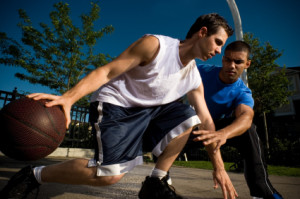Tony Zorger, Riverview Hospital Certified Athletic Trainer
 One of the most publicized sports injuries in recent years has been the anterior cruciate ligament—better known as an ACL—tear. The incident of this injury continues to rise, especially in high-impact sports like football, basketball, soccer, volleyball and baseball. This often season-ending, and in some cases, career-ending injury has affected many of today’s famous professional athletes such as Adrian Peterson, Darrelle Revis, Robert Griffin III and Derrick Rose. But ACL injuries aren’t limited to professional athletes. More and more “club athletes” and “weekend warriors” who participate in year-round sports are seeing a rise in this injury too. Chances are you or someone you know has had a dreaded ACL tear.
One of the most publicized sports injuries in recent years has been the anterior cruciate ligament—better known as an ACL—tear. The incident of this injury continues to rise, especially in high-impact sports like football, basketball, soccer, volleyball and baseball. This often season-ending, and in some cases, career-ending injury has affected many of today’s famous professional athletes such as Adrian Peterson, Darrelle Revis, Robert Griffin III and Derrick Rose. But ACL injuries aren’t limited to professional athletes. More and more “club athletes” and “weekend warriors” who participate in year-round sports are seeing a rise in this injury too. Chances are you or someone you know has had a dreaded ACL tear.
Because ACL tears require surgery and can take up to a year of recovery, it’s no wonder athletic trainers are continually looking for ways to prevent this type of injury. But before we get to how to prevent a tear, it’s important to understand why the ACL is so important.
The ACL is vital to the function and stability of the knee joint. It attaches the femur (thigh) to the tibia (shin) and ensures that the tibia does not slide too far forward during movement. When this ligament tears, any form of sport-specific movement can cause your knee to buckle and put your knee at further risk of bone, tendon or ligament injury. Every injury is different, but a large percentage of ACL tears can be prevented by following proper injury prevention techniques that are based on solid strength and conditioning principles.
So where should you begin? Let’s start with the basics. Riverview Hospital Athletic Trainer, Tony Zorger suggests you begin your workout routine with active warm-up exercises to increase your heart rate and improve blood flow to your muscles. Exercises that activate one muscle while making another longer—such as high knees, buttock kicks and lunges—are the most effective.
After you get your blood pumping, Zorger recommended single-leg exercises that place an emphasis on knee stability and are specific to sports movements. Forward, backward and side-to-side hopping is the best, because it involves jumping and landing on one leg.
Zorger also advises you do plyometric exercises to help maintain and improve the muscles surrounding your knee joint, while building explosiveness and speed. Examples of these exercises include box jumps, hopping over and around objects, and adding a bounce between jumps. But keep tabs on how frequently you do these exercises, because plyometric training cycles should last about three weeks, but they should be done only twice a week.
And finally, Zorger says to incorporate agility exercises into your workout. This includes exercises that test your ability to move quickly and efficiently, such as those that require a rapid change in direction. Emphasize starting and stopping with proper form, and always practice proper landings.
While there’s no guarantee these guidelines will save you from an ACL tear, they can help ensure you’re doing everything possible to prevent it from happening. And all you athletes out there know that staying injury-free means everything in the world of sports!
